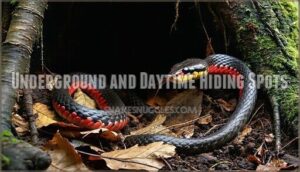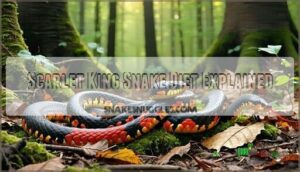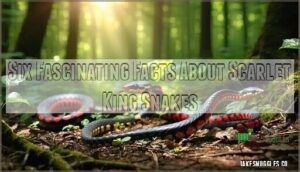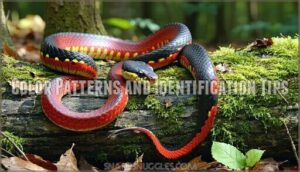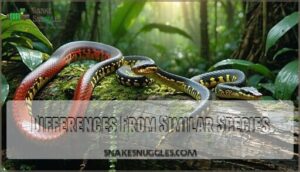This site is supported by our readers. We may earn a commission, at no cost to you, if you purchase through links.
 You’ll find scarlet king snakes spanning from Louisiana to New Jersey, where these adaptable constrictors thrive in pinelands, hardwood hammocks, and suburban areas. They’re opportunistic hunters, eating rodents, lizards, bird eggs, and even venomous snakes.
You’ll find scarlet king snakes spanning from Louisiana to New Jersey, where these adaptable constrictors thrive in pinelands, hardwood hammocks, and suburban areas. They’re opportunistic hunters, eating rodents, lizards, bird eggs, and even venomous snakes.
Six fascinating facts: they mimic coral snakes with their red-yellow-black banding, use powerful constriction to subdue prey, hunt nocturnally while hiding under logs during daylight, display distinctive color patterns that vary regionally, control rodent populations naturally in agricultural areas, and reproduce through temperature-dependent incubation.
These secretive serpents measure 14-20 inches on average, maintaining stable populations despite occasional pet trade pressures and mistaken identity issues with their venomous coral snake lookalikes.
Table Of Contents
- Key Takeaways
- Scarlet King Snake Habitat and Range
- Scarlet King Snake Diet Explained
- Six Fascinating Facts About Scarlet King Snakes
- Scarlet King Snake Physical Features
- Conservation Status and Human Interactions
- Frequently Asked Questions (FAQs)
- What is the primary diet of scarlet king snakes?
- What are some interesting defense mechanisms of scarlet king snakes?
- What is the lifespan of scarlet king snakes in the wild and captivity?
- How long do scarlet king snakes live?
- When do scarlet king snakes typically breed?
- How many eggs do females lay annually?
- What predators threaten scarlet king snakes?
- Are scarlet king snakes good pets?
- Conclusion
Key Takeaways
- You’ll find scarlet king snakes across the southeastern U.S., from Louisiana to New Jersey, where they thrive in diverse habitats like pinelands, hardwood hammocks, and even suburban areas by hiding under logs and leaf litter during the day.
- You can recognize these beneficial constrictors by their red-black-yellow banding pattern that mimics venomous coral snakes – remember "red touches black, friend of Jack" to distinguish them from dangerous coral snakes where "red touches yellow, kill a fellow."
- You’ll appreciate their role as nature’s pest controllers since they’re opportunistic hunters that eat rodents, lizards, bird eggs, and even venomous snakes like rattlesnakes and coral snakes, helping maintain ecological balance in agricultural areas.
- You should know they’re nocturnal and secretive serpents that measure 14-20 inches on average, with stable populations despite occasional pet trade pressures and mistaken killings by people who confuse them with coral snakes.
Scarlet King Snake Habitat and Range
You’ll find Lampropeltis elapsoides across a surprisingly wide range, from eastern Louisiana to southern New Jersey, with healthy populations throughout Florida’s diverse ecosystems.
These adaptable serpents thrive in pinelands, hardwood hammocks, prairies, and even suburban areas, though you’re most likely to spot them hiding beneath bark, logs, or leaf litter during daylight hours.
Native Regions in The U.S
You’ll find scarlet king snakes throughout the eastern United States, from southern New Jersey down to Florida and west to eastern Louisiana. These adaptable serpents call pinelands, hardwood hammocks, and suburban areas home.
Regional variations exist across their range, with Population Density varying due to Habitat Loss from development. Climate Impact affects their distribution, making Conservation Efforts essential for maintaining healthy populations across these diverse habitats.
They’re considered non-venomous snakes, posing no threat to humans or pets.
Preferred Habitats and Microhabitats
You’ll discover scarlet kingsnakes thriving across diverse microhabitat preferences, from Florida’s pinelands to hardwood hammocks and suburban areas. These adaptable serpents navigate habitat fragmentation by utilizing various snake habitats, including cultivated fields and wetland areas.
Their forest dependence varies, as they successfully colonize subterranean habitats beneath bark and leaf litter. Habitat conservation efforts protect these valuable ecosystems that support healthy populations.
Underground and Daytime Hiding Spots
You’ll spot Scarlet Kingsnakes exhibiting burrowing behavior beneath logs, rocks, and loose bark during daylight hours. Their moisture preference leads them to damp leaf litter and underground burrows.
Seasonal variation affects hiding spots, with deeper retreats during winter. These camouflage tactics help them avoid snake predators.
Habitat disturbance from development forces them to seek new underground refuges.
Scarlet King Snake Diet Explained
You’ll discover that scarlet kingsnakes (Lampropeltis triangulum elapsoides) are opportunistic carnivores with remarkably diverse feeding habits.
These skilled constrictors hunt rodents, lizards, bird eggs, and even other snakes, including venomous species like coral snakes and rattlesnakes.
Common Prey (Rodents, Lizards, Eggs)
Scarlet King Snakes are opportunistic predators with diverse dietary adaptations. Their snake diet includes small mammals, rodents, lizards, bird eggs, and other reptiles.
These carnivores use powerful hunting techniques, employing constriction to subdue prey. Prey defenses like speed rarely escape their quick strikes.
The prey nutritional value varies seasonally, with rodent populations providing protein-rich meals. Seasonal availability influences their feeding patterns throughout the year.
Eating Other Snakes, Including Venomous Species
Beyond smaller prey, scarlet king snakes show notable cannibalistic behavior, specializing in eating other snakes. Their venom resistance allows them to tackle venomous coral snakes and pit vipers through powerful constriction. Notably, this resistance isn’t universal, as they’re still vulnerable to certain venoms.
Here’s how snake predation works: 1. Prey Selection – They target slender snakes about 19% of their body mass 2. Venom Resistance – Blood enzymes neutralize pit viper venom partially 3. Constriction Technique – They bend prey’s spine into waves for easier swallowing 4. Headfirst Consumption – Always swallow snake prey headfirst to avoid bites 5. Digestion Process – Complete breakdown occurs within 15 days maximum
This ophiophagy represents 15% of their diet, making kingsnakes valuable controllers of venomous snake populations. Their venom resistance varies depending on the snake species.
Six Fascinating Facts About Scarlet King Snakes
You’ll discover that Lampropeltis elapsoides displays notable behavioral adaptations that help it survive in diverse habitats across the southeastern United States.
These fascinating characteristics, from their clever mimicry strategies to their unique reproductive biology, demonstrate why field researchers consider scarlet kingsnakes among the most intriguing colubrids in North America.
Fact 1 – Mimicry of Venomous Coral Snakes
You’re looking at nature’s greatest con artist. The scarlet king snake perfects Batesian mimicry by copying venomous coral snakes’ warning colors.
This nonvenomous species evolved coral snake lookalikes through mimetic coloration, gaining evolutionary advantages in predator avoidance. When threatened, mimicry effectiveness tricks potential predators into thinking they face a deadly opponent, keeping the harmless snake safe.
Fact 2 – Powerful Constriction Abilities
How do scarlet kingsnakes overpower their prey? These reptiles rely on muscular anatomy and powerful constriction strength to subdue meals through prey suffocation techniques.
- Kingsnakes wrap coils around victims, applying pressure that stops breathing
- Hunting techniques involve quick strikes followed by immediate body wrapping
- Muscular anatomy allows sustained squeezing until prey stops moving completely
- Snake behavior includes swallowing whole animals after successful constriction kills
- Digestive process begins once prey suffocation eliminates struggling from potential predators
This hunting method proves essential for curbing rodent populations effectively.
Fact 3 – Nocturnal and Secretive Behavior
You’ll rarely spot these elusive serpents during daylight hours. The scarlet king snake embraces a secretive lifestyle, emerging only after sunset for hunting behavior.
Their nocturnal adaptations include enhanced sensory abilities for predator avoidance. Activity patterns center around underground retreats beneath logs, rocks, or leaf litter.
This snake behavior makes snake identification challenging within their snake range, as they prefer darkness over daytime exposure.
Fact 4 – Colorful and Distinctive Patterns
You’ll recognize a Scarlet King Snake by its striking coloration mimicry that protects it from predators. These serpents display vivid pattern variations with distinctive ring arrangements.
Snake identification becomes easier when you notice these five key features:
- Red nose extending from the snout
- Red and yellow rings bordered by black rings
- Bright colors forming complete body bands
- Ventral patterns matching dorsal markings
- Alternating color sequences creating warning signals
This remarkable display helps distinguish them from dangerous coral snakes.
Fact 5 – Role in Controlling Rodent Populations
You’ll appreciate how these snakes serve as nature’s pest controllers. Scarlet king snakes excel at curbing rodent populations, maintaining essential ecosystem balance in agricultural areas.
Their natural pest control abilities reduce crop damage while supporting disease control efforts. By consuming mice, rats, and other small mammals, they help preserve regional food chains and natural populations.
This rodent population control makes them valuable allies for farmers and homeowners alike.
Fact 6 – Incubation Temperature Influences Offspring Sex
Unlike many reptiles, scarlet king snakes don’t rely on nest temperature for sex determination. These snakes use chromosomal sex determination instead of temperature-dependent mechanisms.
While incubation temperature affects hatching success and development speed in their eggs, it doesn’t influence hatchling ratios or create the climate impacts seen in turtle species.
This evolutionary advantage ensures balanced clutch size outcomes regardless of environmental temperature fluctuations during snake reproduction.
Scarlet King Snake Physical Features
You’ll recognize a scarlet kingsnake by its striking red, black, and yellow banded pattern that completely encircles its slender body, with red bands always bordered by black bands rather than yellow. These compact serpents usually measure 14-20 inches in length as adults, featuring a distinctive reddish snout and a checkered belly pattern that mirrors their dorsal coloration.
Size and Body Shape
You’ll find the Scarlet Kingsnake’s body proportions quite compact for a snake. These slender reptiles measure out at specific dimensions:
- Average Length: Most adults reach 14-20 inches total
- Maximum Length: Record holders hit 68.5 cm (about 27 inches)
- Body Shape: Thin, cylindrical build with uniform dorsal size
- Sexual Dimorphism: Males and females show minimal size differences
Their growth rate stays steady throughout development, with scale count remaining consistent across individuals.
Color Patterns and Identification Tips
Scarlet kingsnakes display distinctive banding patterns that help with accurate identification. Their red and yellow rings are separated by black bands, creating a recognizable sequence. Pattern variations occur across regions, with some individuals showing aberrant coloration or incomplete rings around entire body. This mimicry accuracy helps distinguish them from coral snakes during field observations.
| Feature | Scarlet Kingsnake | Coral Snake |
|---|---|---|
| Band Pattern | Red touches black | Red touches yellow |
| Ring Completion | Often incomplete | Complete rings |
| Snout Color | Red/orange | Black |
| Size | 14-20 inches | 20-30 inches |
| Body Shape | Thin, slender | Stockier build |
Differences From Similar Species
Recognizing similar species requires sharp eyes and knowledge. You’ll encounter Coral Snake Mimicry through perfect red-black-yellow rings, avoiding Milk Snake Confusion with proper identification. These differences matter:
- Color Pattern Variations: Scarlet Kingsnake shows red touching black rings; coral snake displays red touching yellow
- Scale Count Differences: Smooth scales distinguish milksnakes from coral snakes’ rougher texture
- Venom Presence: Only coral snakes are venomous among lookalikes
- Belly patterns: Scarlet snakes lack complete rings underneath
Practice makes perfect when identifying these harmless mimics.
Conservation Status and Human Interactions
You’ll be relieved to know that scarlet kingsnakes (Lampropeltis elapsoides) maintain stable populations across their range, earning a "Least Concern" status from the IUCN despite ongoing habitat changes.
However, you should be aware that excessive collection for the pet trade and mistaken identity killings can impact local populations, since many people can’t distinguish these harmless constrictors from venomous coral snakes.
IUCN Listing and Population Trends
Within verified county records and city occurrence data, the IUCN Red List classifies scarlet kingsnakes as Least Concern, reflecting strong population stability. These reptiles show no major population parameters indicating decline.
Conservation efforts focus on monitoring habitat loss, while ongoing data collection confirms their widespread distribution. Ecology and conservation assessments suggest minimal future threats to both aquatic terrestrial environments they inhabit.
Pet Trade and Collection Concerns
Pet trade pressures threaten wild Scarlet King Snake populations through overcollection and habitat disruption. You’ll find these beautiful reptiles facing serious conservation challenges from human encounters.
Key Collection Impact Concerns:
- Wild harvesting depletes local populations faster than natural reproduction rates
- Regulation enforcement remains inconsistent across states, allowing illegal trade to continue
- Captive breeding programs lag behind demand, forcing continued wild collection
Sustainable practices and ethical considerations must guide future pet trade decisions. Ecology and Conservation experts recommend stricter oversight to protect remaining populations.
Confusion With Coral Snakes and Safety Rhymes
Distinguishing Scarlet King Snakes from venomous coral snakes can literally save your life. The famous safety rhyme origins trace back decades: "Red touches yellow, kill a fellow; red touches black, friend of Jack."
The famous safety rhyme red touches yellow, kill a fellow; red touches black, friend of Jack can literally save your life when distinguishing harmless kingsnakes from deadly coral snakes
However, coral snake mimicry isn’t foolproof. Sometimes snakes don’t match field guide photos perfectly. Public education emphasizes Snake Comparison techniques and first aid preparation rather than relying solely on rings patterns.
Frequently Asked Questions (FAQs)
What is the primary diet of scarlet king snakes?
You’ll find scarlet kingsnakes are carnivorous predators that eat rodents, birds, eggs, lizards, and other snakes. They’re particularly notable for consuming venomous species like rattlesnakes and coral snakes without harm.
What are some interesting defense mechanisms of scarlet king snakes?
Like telegraph operators of old, you’ll spot scarlet kingsnakes using Batesian mimicry—copying coral snake colors for protection.
They’ll startle predators with quick movements and bright warning signals that confuse threats.
What is the lifespan of scarlet king snakes in the wild and captivity?
Scarlet kingsnakes (Lampropeltis elapsoides) live substantially longer in captivity than in the wild. You’ll find they reach up to 22 years in captivity, while wild specimens usually survive much shorter lifespans due to predation and environmental challenges.
How long do scarlet king snakes live?
You’ll find that scarlet king snakes (Lampropeltis elapsoides) usually live 10-15 years in the wild, but can reach up to 22 years in captivity with proper care.
When do scarlet king snakes typically breed?
Timing perfect like clockwork, scarlet kingsnakes breed during March through June. You’ll witness their spring romance when temperatures warm consistently. Females then lay eggs throughout summer months.
How many eggs do females lay annually?
Female scarlet kingsnakes usually lay 2-12 eggs annually, with Florida populations averaging 2-8 eggs per clutch. You’ll find these eggs deposited underground or beneath rotting logs during summer months.
What predators threaten scarlet king snakes?
Nature’s food chain doesn’t play favorites with scarlet kingsnakes. You’ll find foxes, raccoons, coyotes, and skunks hunting these colorful serpents.
Meanwhile, humans mistakenly kill them, thinking they’re venomous coral snakes instead.
Are scarlet king snakes good pets?
You can keep them as pets, but they’re challenging for beginners. They need specific temperatures, humidity, and feeding schedules. Consider their nocturnal nature and potential twenty-year commitment before deciding.
Conclusion
Understanding scarlet king snakes’ habitat, diet, and 6 interesting facts transforms you into an absolutely unstoppable wildlife enthusiast! You’ve discovered how these notable constrictors thrive across diverse southeastern ecosystems while maintaining essential ecological balance.
Their opportunistic feeding habits, from rodents to venomous snakes, demonstrate nature’s perfect pest control system. Remember the coral snake rhyme when identifying these beneficial mimics.
Whether you’re hiking through pinelands or exploring suburban areas, you’ll now appreciate these secretive nocturnal hunters and their important role in maintaining healthy environments.
- https://auth1.dpr.ncparks.gov/reptiles/view.php?sort_order_num=138.0
- https://ufwildlife.ifas.ufl.edu/snakes/scarletkingsnake.shtml
- https://www.virginiaherpetologicalsociety.com/reptiles/snakes/scarlet-kingsnake/index.php
- https://critter.science/the-scarlet-kingsnake/
- https://www.snakeestate.com/kingsnakes/scarlet-kingsnake/



